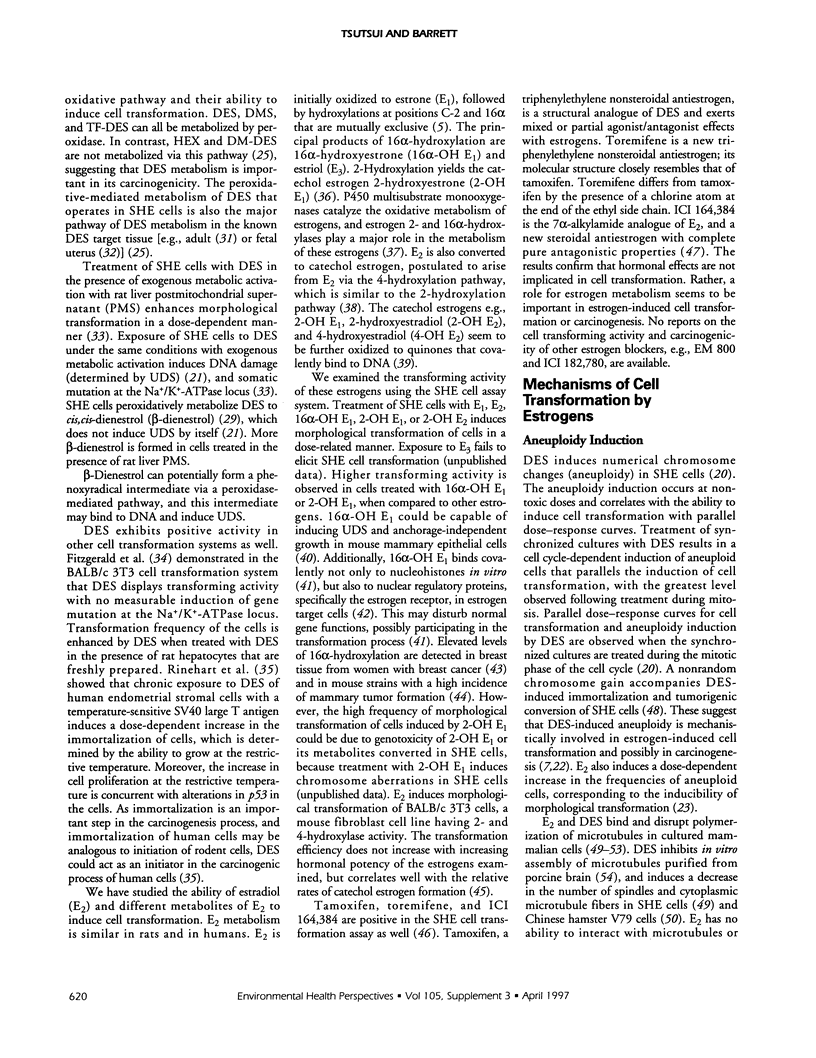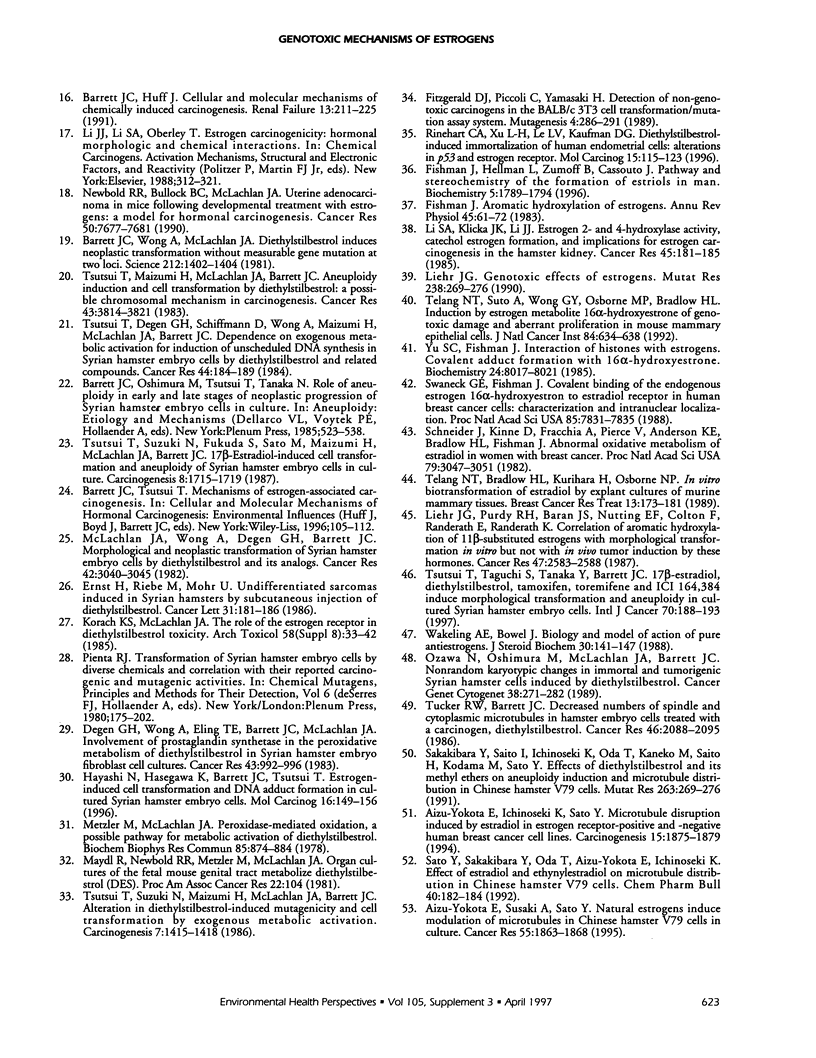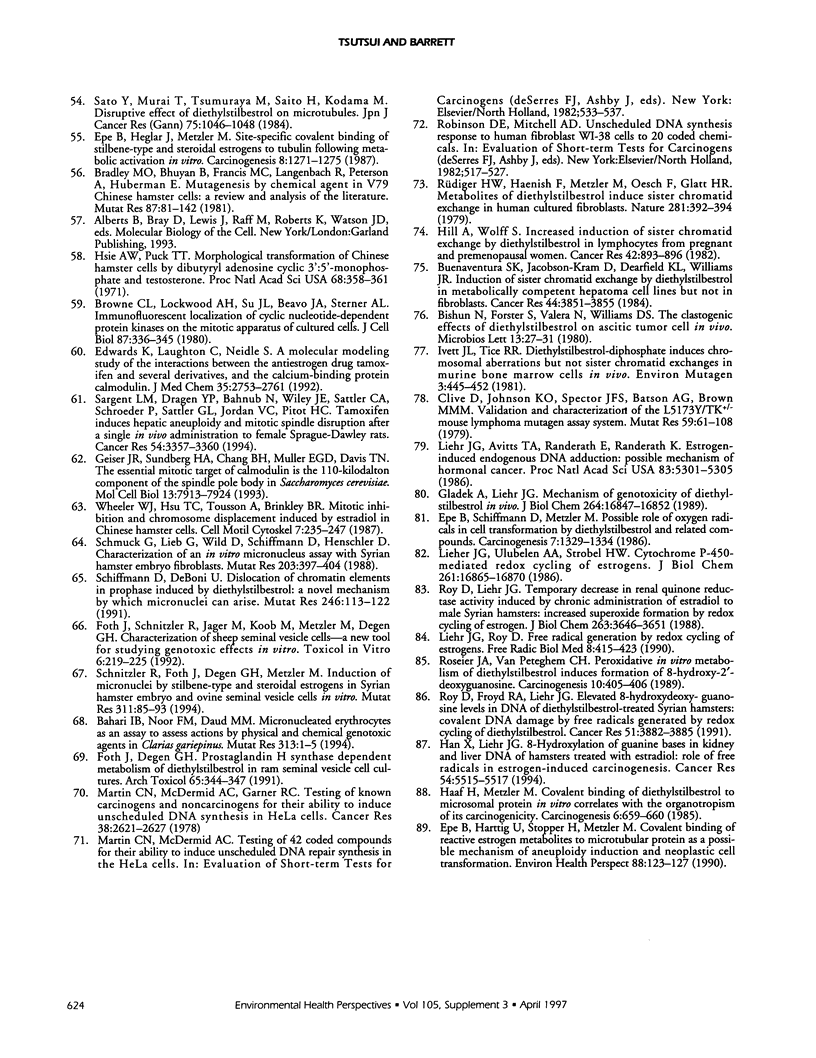Abstract
Estrogens are clearly carcinogenic in humans and rodents but the mechanisms by which these hormones induce cancer are only partially understood. Stimulation of cell proliferation and gene expression by binding to the estrogen receptor is one important mechanism in hormonal carcinogenesis; however, estrogenicity is not sufficient to explain the carcinogenic activity of all estrogens because some estrogens are not carcinogenic. Estrogens are nonmutagenic in many assays but exhibit specific types of genotoxic activity under certain conditions. We have studied extensively the mechanisms by which estrogens induce neoplastic transformation in a model in vitro system and our findings are summarized in this review. 17beta-Estradiol (E2) and diethylstilbestrol (DES) and their metabolites induce morphological and neoplastic transformation of Syrian hamster embryo (SHE) cells that express no measurable levels of estrogen receptor. Treatment of the cells with E2 or DES fails to induce DNA damage, chromosome aberrations and gene mutations in SHE cells but results in numerical chromosome aberrations (aneuploidy) that could arise from microtubule disruption or disfunction of mitotic apparatus. Estrogen-induced genotoxicity is detected in cells following treatment with estrogen metabolites or following exogenous metabolic activation of estrogens. The estrogens induce DNA adduct formation that is detected by 32P-postlabeling. Both aneuploidy induction and DNA damage caused by DNA adduct formation correlate with the estrogen-induced cell transformation and may be important in hormonal carcinogenesis. We propose that multiple effects of estrogens acting together cause genetic alterations leading to cell transformation.
Full text
PDF





Selected References
These references are in PubMed. This may not be the complete list of references from this article.
- Aizu-Yokota E., Ichinoseki K., Sato Y. Microtubule disruption induced by estradiol in estrogen receptor-positive and -negative human breast cancer cell lines. Carcinogenesis. 1994 Sep;15(9):1875–1879. doi: 10.1093/carcin/15.9.1875. [DOI] [PubMed] [Google Scholar]
- Aizu-Yokota E., Susaki A., Sato Y. Natural estrogens induce modulation of microtubules in Chinese hamster V79 cells in culture. Cancer Res. 1995 May 1;55(9):1863–1868. [PubMed] [Google Scholar]
- Bahari I. B., Noor F. M., Daud N. M. Micronucleated erythrocytes as an assay to assess actions by physical and chemical genotoxic agents in Clarias gariepinus. Mutat Res. 1994 Aug;313(1):1–5. doi: 10.1016/0165-1161(94)90027-2. [DOI] [PubMed] [Google Scholar]
- Barrett J. C., Hesterberg T. W., Oshimura M., Tsutsui T. Role of chemically induced mutagenic events in neoplastic transformation of Syrian hamster embryo cells. Carcinog Compr Surv. 1985;9:123–137. [PubMed] [Google Scholar]
- Barrett J. C., Huff J. Cellular and molecular mechanisms of chemically induced renal carcinogenesis. Ren Fail. 1991;13(4):211–225. doi: 10.3109/08860229109022157. [DOI] [PubMed] [Google Scholar]
- Barrett J. C., Oshimura M., Tanaka N., Tsutsui T. Role of aneuploidy in early and late stages of neoplastic progression of Syrian hamster embryo cells in culture. Basic Life Sci. 1985;36:523–538. doi: 10.1007/978-1-4613-2127-9_36. [DOI] [PubMed] [Google Scholar]
- Barrett J. C., Wong A., McLachlan J. A. Diethylstilbestrol induces neoplastic transformation without measurable gene mutation at two loci. Science. 1981 Jun 19;212(4501):1402–1404. doi: 10.1126/science.6262919. [DOI] [PubMed] [Google Scholar]
- Bradley M. O., Bhuyan B., Francis M. C., Langenbach R., Peterson A., Huberman E. Mutagenesis by chemical agents in V79 chinese hamster cells: a review and analysis of the literature. A report of the Gene-Tox Program. Mutat Res. 1981 Sep;87(2):81–142. doi: 10.1016/0165-1110(81)90029-4. [DOI] [PubMed] [Google Scholar]
- Brinton L. A., Hoover R., Fraumeni J. F., Jr Menopausal oestrogens and breast cancer risk: an expanded case-control study. Br J Cancer. 1986 Nov;54(5):825–832. doi: 10.1038/bjc.1986.246. [DOI] [PMC free article] [PubMed] [Google Scholar]
- Browne C. L., Lockwood A. H., Su J. L., Beavo J. A., Steiner A. L. Immunofluorescent localization of cyclic nucleotide-dependent protein kinases on the mitotic apparatus of cultured cells. J Cell Biol. 1980 Nov;87(2 Pt 1):336–345. doi: 10.1083/jcb.87.2.336. [DOI] [PMC free article] [PubMed] [Google Scholar]
- Buenaventura S. K., Jacobson-Kram D., Dearfield K. L., Williams J. R. Induction of sister chromatid exchange by diethylstilbestrol in metabolically competent hepatoma cell lines but not in fibroblasts. Cancer Res. 1984 Sep;44(9):3851–3855. [PubMed] [Google Scholar]
- Clive D., Johnson K. O., Spector J. F., Batson A. G., Brown M. M. Validation and characterization of the L5178Y/TK+/- mouse lymphoma mutagen assay system. Mutat Res. 1979 Jan;59(1):61–108. doi: 10.1016/0027-5107(79)90195-7. [DOI] [PubMed] [Google Scholar]
- Degen G. H., Wong A., Eling T. E., Barrett J. C., McLachlan J. A. Involvement of prostaglandin synthetase in the peroxidative metabolism of diethylstilbestrol in Syrian hamster embryo fibroblast cell cultures. Cancer Res. 1983 Mar;43(3):992–996. [PubMed] [Google Scholar]
- Edwards K. J., Laughton C. A., Neidle S. A molecular modeling study of the interactions between the antiestrogen drug tamoxifen and several derivatives, and the calcium-binding protein calmodulin. J Med Chem. 1992 Jul 24;35(15):2753–2761. doi: 10.1021/jm00093a006. [DOI] [PubMed] [Google Scholar]
- Epe B., Harttig U., Stopper H., Metzler M. Covalent binding of reactive estrogen metabolites to microtubular protein as a possible mechanism of aneuploidy induction and neoplastic cell transformation. Environ Health Perspect. 1990 Aug;88:123–127. doi: 10.1289/ehp.9088123. [DOI] [PMC free article] [PubMed] [Google Scholar]
- Epe B., Hegler J., Metzler M. Site-specific covalent binding of stilbene-type and steroidal estrogens to tubulin following metabolic activation in vitro. Carcinogenesis. 1987 Sep;8(9):1271–1275. doi: 10.1093/carcin/8.9.1271. [DOI] [PubMed] [Google Scholar]
- Epe B., Schiffmann D., Metzler M. Possible role of oxygen radicals in cell transformation by diethylstilbestrol and related compounds. Carcinogenesis. 1986 Aug;7(8):1329–1334. doi: 10.1093/carcin/7.8.1329. [DOI] [PubMed] [Google Scholar]
- Ernst H., Riebe M., Mohr U. Undifferentiated sarcomas induced in Syrian hamsters by subcutaneous injection of diethylstilbestrol. Cancer Lett. 1986 May;31(2):181–186. doi: 10.1016/0304-3835(86)90009-1. [DOI] [PubMed] [Google Scholar]
- Fishman J. Aromatic hydroxylation of estrogens. Annu Rev Physiol. 1983;45:61–72. doi: 10.1146/annurev.ph.45.030183.000425. [DOI] [PubMed] [Google Scholar]
- Fishman J., Hellman L., Zumoff B., Cassouto J. Pathway and stereochemistry of the formation of estriols in man. Biochemistry. 1966 Jun;5(6):1789–1794. doi: 10.1021/bi00870a003. [DOI] [PubMed] [Google Scholar]
- Fitzgerald D. J., Piccoli C., Yamasaki H. Detection of non-genotoxic carcinogens in the BALB/c 3T3 cell transformation/mutation assay system. Mutagenesis. 1989 Jul;4(4):286–291. doi: 10.1093/mutage/4.4.286. [DOI] [PubMed] [Google Scholar]
- Foth J., Degen G. H. Prostaglandin H synthase dependent metabolism of diethylstilbestrol by ram seminal vesicle cell cultures. Arch Toxicol. 1991;65(4):344–347. doi: 10.1007/BF01968971. [DOI] [PubMed] [Google Scholar]
- Geiser J. R., Sundberg H. A., Chang B. H., Muller E. G., Davis T. N. The essential mitotic target of calmodulin is the 110-kilodalton component of the spindle pole body in Saccharomyces cerevisiae. Mol Cell Biol. 1993 Dec;13(12):7913–7924. doi: 10.1128/mcb.13.12.7913. [DOI] [PMC free article] [PubMed] [Google Scholar]
- Gladek A., Liehr J. G. Mechanism of genotoxicity of diethylstilbestrol in vivo. J Biol Chem. 1989 Oct 5;264(28):16847–16852. [PubMed] [Google Scholar]
- Grubbs C. J., Peckham J. C., McDonough K. D. Effect of ovarian hormones on the induction of 1-methyl-1-nitrosourea-induced mammary cancer. Carcinogenesis. 1983;4(4):495–497. doi: 10.1093/carcin/4.4.495. [DOI] [PubMed] [Google Scholar]
- Haaf H., Metzler M. Covalent binding of diethylstilbestrol to microsomal protein in vitro correlates with the organotropism of its carcinogenicity. Carcinogenesis. 1985 Apr;6(4):659–660. doi: 10.1093/carcin/6.4.659. [DOI] [PubMed] [Google Scholar]
- Han X., Liehr J. G. 8-Hydroxylation of guanine bases in kidney and liver DNA of hamsters treated with estradiol: role of free radicals in estrogen-induced carcinogenesis. Cancer Res. 1994 Nov 1;54(21):5515–5517. [PubMed] [Google Scholar]
- Hayashi N., Hasegawa K., Komine A., Tanaka Y., McLachian J. A., Barrett J. C., Tsutsui T. Estrogen-induced cell transformation and DNA adduct formation in cultured Syrian hamster embryo cells. Mol Carcinog. 1996 Jul;16(3):149–156. doi: 10.1002/(SICI)1098-2744(199607)16:3<149::AID-MC5>3.0.CO;2-C. [DOI] [PubMed] [Google Scholar]
- Herbst A. L., Ulfelder H., Poskanzer D. C. Adenocarcinoma of the vagina. Association of maternal stilbestrol therapy with tumor appearance in young women. N Engl J Med. 1971 Apr 15;284(15):878–881. doi: 10.1056/NEJM197104222841604. [DOI] [PubMed] [Google Scholar]
- Hill A., Wolff S. Increased induction of sister chromatid exchange by diethylstilbestrol in lymphocytes from pregnant and premenopausal women. Cancer Res. 1982 Mar;42(3):893–896. [PubMed] [Google Scholar]
- Hsie A. W., Puck T. T. Morphological transformation of Chinese hamster cells by dibutyryl adenosine cyclic 3':5'-monophosphate and testosterone. Proc Natl Acad Sci U S A. 1971 Feb;68(2):358–361. doi: 10.1073/pnas.68.2.358. [DOI] [PMC free article] [PubMed] [Google Scholar]
- Ivett J. L., Tice R. R. Diethylstilbestrol-diphosphate induces chromosomal aberrations but not sister chromatid exchanges in murine bone marrow cells in vivo. Environ Mutagen. 1981;3(4):445–452. doi: 10.1002/em.2860030405. [DOI] [PubMed] [Google Scholar]
- KIRKMAN H. Estrogen-induced tumors of the kidney. III. Growth characteristics in the Syrian hamster. Natl Cancer Inst Monogr. 1959 Dec;1:1–57. [PubMed] [Google Scholar]
- Korach K. S., McLachlan J. A. The role of the estrogen receptor in diethylstilbestrol toxicity. Arch Toxicol Suppl. 1985;8:33–42. doi: 10.1007/978-3-642-69928-3_4. [DOI] [PubMed] [Google Scholar]
- Li S. A., Klicka J. K., Li J. J. Estrogen 2- and 4-hydroxylase activity, catechol estrogen formation, and implications for estrogen carcinogenesis in the hamster kidney. Cancer Res. 1985 Jan;45(1):181–185. [PubMed] [Google Scholar]
- Liehr J. G., Avitts T. A., Randerath E., Randerath K. Estrogen-induced endogenous DNA adduction: possible mechanism of hormonal cancer. Proc Natl Acad Sci U S A. 1986 Jul;83(14):5301–5305. doi: 10.1073/pnas.83.14.5301. [DOI] [PMC free article] [PubMed] [Google Scholar]
- Liehr J. G. Genotoxic effects of estrogens. Mutat Res. 1990 May;238(3):269–276. doi: 10.1016/0165-1110(90)90018-7. [DOI] [PubMed] [Google Scholar]
- Liehr J. G., Purdy R. H., Baran J. S., Nutting E. F., Colton F., Randerath E., Randerath K. Correlation of aromatic hydroxylation of 11 beta-substituted estrogens with morphological transformation in vitro but not with in vivo tumor induction by these hormones. Cancer Res. 1987 May 15;47(10):2583–2588. [PubMed] [Google Scholar]
- Liehr J. G., Roy D. Free radical generation by redox cycling of estrogens. Free Radic Biol Med. 1990;8(4):415–423. doi: 10.1016/0891-5849(90)90108-u. [DOI] [PubMed] [Google Scholar]
- Liehr J. G., Ulubelen A. A., Strobel H. W. Cytochrome P-450-mediated redox cycling of estrogens. J Biol Chem. 1986 Dec 25;261(36):16865–16870. [PubMed] [Google Scholar]
- Martin C. N., McDermid A. C., Garner R. C. Testing of known carcinogens and noncarcinogens for their ability to induce unscheduled DNA synthesis in HeLa cells. Cancer Res. 1978 Aug;38(8):2621–2627. [PubMed] [Google Scholar]
- McLachlan J. A., Wong A., Degen G. H., Barrett J. C. Morphologic and neoplastic transformation of Syrian hamster embryo fibroblasts by diethylstilbestrol and its analogs. Cancer Res. 1982 Aug;42(8):3040–3045. [PubMed] [Google Scholar]
- Metzler M., McLachlan J. A. Peroxidase-mediated oxidation, a possible pathway for metabolic activation of diethylstilbestrol. Biochem Biophys Res Commun. 1978 Dec 14;85(3):874–884. doi: 10.1016/0006-291x(78)90625-3. [DOI] [PubMed] [Google Scholar]
- Moolgavkar S. H., Knudson A. G., Jr Mutation and cancer: a model for human carcinogenesis. J Natl Cancer Inst. 1981 Jun;66(6):1037–1052. doi: 10.1093/jnci/66.6.1037. [DOI] [PubMed] [Google Scholar]
- Newbold R. R., Bullock B. C., McLachlan J. A. Uterine adenocarcinoma in mice following developmental treatment with estrogens: a model for hormonal carcinogenesis. Cancer Res. 1990 Dec 1;50(23):7677–7681. [PubMed] [Google Scholar]
- Noronha R. F., Goodall C. M. The effects of estrogen on single dose dimethylnitrosamine carcinogenesis in male inbred Crl/CDF rats. Carcinogenesis. 1984 Aug;5(8):1003–1007. doi: 10.1093/carcin/5.8.1003. [DOI] [PubMed] [Google Scholar]
- Ozawa N., Oshimura M., McLachlan J. A., Barrett J. C. Nonrandom karyotypic changes in immortal and tumorigenic Syrian hamster cells induced by diethylstilbestrol. Cancer Genet Cytogenet. 1989 Apr;38(2):271–282. doi: 10.1016/0165-4608(89)90669-9. [DOI] [PubMed] [Google Scholar]
- Rinehart C. A., Xu L. H., Van Le L., Kaufman D. G. Diethylstilbestrol-induced immortalization of human endometrial cells: alterations in p53 and estrogen receptor. Mol Carcinog. 1996 Feb;15(2):115–123. doi: 10.1002/(SICI)1098-2744(199602)15:2<115::AID-MC4>3.0.CO;2-I. [DOI] [PubMed] [Google Scholar]
- Rosier J. A., Van Peteghem C. H. Peroxidative in vitro metabolism of diethylstilbestrol induces formation of 8-hydroxy-2'-deoxyguanosine. Carcinogenesis. 1989 Feb;10(2):405–406. doi: 10.1093/carcin/10.2.405. [DOI] [PubMed] [Google Scholar]
- Roy D., Floyd R. A., Liehr J. G. Elevated 8-hydroxydeoxyguanosine levels in DNA of diethylstilbestrol-treated Syrian hamsters: covalent DNA damage by free radicals generated by redox cycling of diethylstilbestrol. Cancer Res. 1991 Aug 1;51(15):3882–3885. [PubMed] [Google Scholar]
- Roy D., Liehr J. G. Temporary decrease in renal quinone reductase activity induced by chronic administration of estradiol to male Syrian hamsters. Increased superoxide formation by redox cycling of estrogen. J Biol Chem. 1988 Mar 15;263(8):3646–3651. [PubMed] [Google Scholar]
- Rüdiger H. W., Haenisch F., Metzler M., Oesch F., Glatt H. R. Metabolites of diethylstilboestrol induce sister chromatid exchange in human cultured fibroblasts. Nature. 1979 Oct 4;281(5730):392–394. doi: 10.1038/281392a0. [DOI] [PubMed] [Google Scholar]
- Sakakibara Y., Saito I., Ichinoseki K., Oda T., Kaneko M., Saitô H., Kodama M., Sato Y. Effects of diethylstilbestrol and its methyl ethers on aneuploidy induction and microtubule distribution in Chinese hamster V79 cells. Mutat Res. 1991 Aug;263(4):269–276. doi: 10.1016/0165-7992(91)90012-s. [DOI] [PubMed] [Google Scholar]
- Sargent L. M., Dragan Y. P., Bahnub N., Wiley J. E., Sattler C. A., Schroeder P., Sattler G. L., Jordan V. C., Pitot H. C. Tamoxifen induces hepatic aneuploidy and mitotic spindle disruption after a single in vivo administration to female Sprague-Dawley rats. Cancer Res. 1994 Jul 1;54(13):3357–3360. [PubMed] [Google Scholar]
- Sato Y., Murai T., Tsumuraya M., Saitô H., Kodama M. Disruptive effect of diethylstilbestrol on microtubules. Gan. 1984 Dec;75(12):1046–1048. [PubMed] [Google Scholar]
- Sato Y., Sakakibara Y., Oda T., Aizu-Yokota E., Ichinoseki K. Effect of estradiol and ethynylestradiol on microtubule distribution in Chinese hamster V79 cells. Chem Pharm Bull (Tokyo) 1992 Jan;40(1):182–184. doi: 10.1248/cpb.40.182. [DOI] [PubMed] [Google Scholar]
- Satyaswaroop P. G., Zaino R. J., Mortel R. Human endometrial adenocarcinoma transplanted into nude mice: growth regulation by estradiol. Science. 1983 Jan 7;219(4580):58–60. doi: 10.1126/science.6849115. [DOI] [PubMed] [Google Scholar]
- Schiffmann D., De Boni U. Dislocation of chromatin elements in prophase induced by diethylstilbestrol: a novel mechanism by which micronuclei can arise. Mutat Res. 1991 Jan;246(1):113–122. doi: 10.1016/0027-5107(91)90113-3. [DOI] [PubMed] [Google Scholar]
- Schmuck G., Lieb G., Wild D., Schiffmann D., Henschler D. Characterization of an in vitro micronucleus assay with Syrian hamster embryo fibroblasts. Mutat Res. 1988 Dec;203(6):397–404. doi: 10.1016/0165-1161(88)90012-x. [DOI] [PubMed] [Google Scholar]
- Schneider J., Kinne D., Fracchia A., Pierce V., Anderson K. E., Bradlow H. L., Fishman J. Abnormal oxidative metabolism of estradiol in women with breast cancer. Proc Natl Acad Sci U S A. 1982 May;79(9):3047–3051. doi: 10.1073/pnas.79.9.3047. [DOI] [PMC free article] [PubMed] [Google Scholar]
- Schnitzler R., Foth J., Degen G. H., Metzler M. Induction of micronuclei by stilbene-type and steroidal estrogens in Syrian hamster embryo and ovine seminal vesicle cells in vitro. Mutat Res. 1994 Nov 1;311(1):84–93. doi: 10.1016/0027-5107(94)90076-0. [DOI] [PubMed] [Google Scholar]
- Sheehan D. M., Frederick C. B., Branham W. S., Heath J. E. Evidence for estradiol promotion of neoplastic lesions in the rat vagina after initiation with N-methyl-N-nitrosourea. Carcinogenesis. 1982;3(8):957–959. doi: 10.1093/carcin/3.8.957. [DOI] [PubMed] [Google Scholar]
- Swaneck G. E., Fishman J. Covalent binding of the endogenous estrogen 16 alpha-hydroxyestrone to estradiol receptor in human breast cancer cells: characterization and intranuclear localization. Proc Natl Acad Sci U S A. 1988 Nov;85(21):7831–7835. doi: 10.1073/pnas.85.21.7831. [DOI] [PMC free article] [PubMed] [Google Scholar]
- Telang N. T., Bradlow H. L., Kurihara H., Osborne M. P. In vitro biotransformation of estradiol by explant cultures of murine mammary tissues. Breast Cancer Res Treat. 1989 Mar;13(2):173–181. doi: 10.1007/BF01806529. [DOI] [PubMed] [Google Scholar]
- Telang N. T., Suto A., Wong G. Y., Osborne M. P., Bradlow H. L. Induction by estrogen metabolite 16 alpha-hydroxyestrone of genotoxic damage and aberrant proliferation in mouse mammary epithelial cells. J Natl Cancer Inst. 1992 Apr 15;84(8):634–638. doi: 10.1093/jnci/84.8.634. [DOI] [PubMed] [Google Scholar]
- Tsutsui T., Degen G. H., Schiffmann D., Wong A., Maizumi H., McLachlan J. A., Barrett J. C. Dependence on exogenous metabolic activation for induction of unscheduled DNA synthesis in Syrian hamster embryo cells by diethylstilbestrol and related compounds. Cancer Res. 1984 Jan;44(1):184–189. [PubMed] [Google Scholar]
- Tsutsui T., Maizumi H., McLachlan J. A., Barrett J. C. Aneuploidy induction and cell transformation by diethylstilbestrol: a possible chromosomal mechanism in carcinogenesis. Cancer Res. 1983 Aug;43(8):3814–3821. [PubMed] [Google Scholar]
- Tsutsui T., Suzuki N., Fukuda S., Sato M., Maizumi H., McLachlan J. A., Barrett J. C. 17beta-Estradiol-induced cell transformation and aneuploidy of Syrian hamster embryo cells in culture. Carcinogenesis. 1987 Nov;8(11):1715–1719. doi: 10.1093/carcin/8.11.1715. [DOI] [PubMed] [Google Scholar]
- Tsutsui T., Suzuki N., Maizumi H., McLachlan J. A., Barrett J. C. Alteration in diethylstilbestrol-induced mutagenicity and cell transformation by exogenous metabolic activation. Carcinogenesis. 1986 Sep;7(9):1415–1418. doi: 10.1093/carcin/7.9.1415. [DOI] [PubMed] [Google Scholar]
- Tsutsui T., Taguchi S., Tanaka Y., Barrett J. C. 17beta-estradiol, diethylstilbestrol, tamoxifen, toremifene and ICI 164,384 induce morphological transformation and aneuploidy in cultured Syrian hamster embryo cells. Int J Cancer. 1997 Jan 17;70(2):188–193. doi: 10.1002/(sici)1097-0215(19970117)70:2<188::aid-ijc9>3.0.co;2-t. [DOI] [PubMed] [Google Scholar]
- Tucker R. W., Barrett J. C. Deceased numbers of spindle and cytoplasmic microtubules in hamster embryo cells treated with a carcinogen, diethylstilbestrol. Cancer Res. 1986 Apr;46(4 Pt 2):2088–2095. [PubMed] [Google Scholar]
- Wakeling A. E., Bowler J. Biology and mode of action of pure antioestrogens. J Steroid Biochem. 1988;30(1-6):141–147. doi: 10.1016/0022-4731(88)90086-6. [DOI] [PubMed] [Google Scholar]
- Wheeler W. J., Hsu T. C., Tousson A., Brinkley B. R. Mitotic inhibition and chromosome displacement induced by estradiol in Chinese hamster cells. Cell Motil Cytoskeleton. 1987;7(3):235–247. doi: 10.1002/cm.970070306. [DOI] [PubMed] [Google Scholar]
- Yager J. D., Campbell H. A., Longnecker D. S., Roebuck B. D., Benoit M. C. Enhancement of hepatocarcinogenesis in female rats by ethinyl estradiol and mestranol but not estradiol. Cancer Res. 1984 Sep;44(9):3862–3869. [PubMed] [Google Scholar]
- Yager J. D., Jr, Yager R. Oral contraceptive steroids as promoters of hepatocarcinogenesis in female Sprague-Dawley rats. Cancer Res. 1980 Oct;40(10):3680–3685. [PubMed] [Google Scholar]
- Yu S. C., Fishman J. Interaction of histones with estrogens. Covalent adduct formation with 16 alpha-hydroxyestrone. Biochemistry. 1985 Dec 31;24(27):8017–8021. doi: 10.1021/bi00348a027. [DOI] [PubMed] [Google Scholar]


